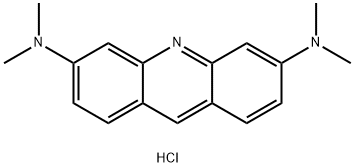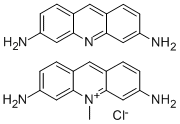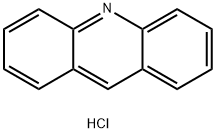ACRIDINE ORANGE
Synonym(s):3,6-Bis(dimethylamino)acridine hydrochloride;Acridine Orange - CAS 65-61-2 - Calbiochem;AO, 3,6- bis(Dimethylamino)acridine, HCl
- CAS NO.:65-61-2
- Empirical Formula: C17H20ClN3
- Molecular Weight: 301.82
- MDL number: MFCD00012660
- EINECS: 200-614-0
- SAFETY DATA SHEET (SDS)
- Update Date: 2024-12-18 13:37:16

What is ACRIDINE ORANGE?
Chemical properties
dark orange to brown powder
The Uses of ACRIDINE ORANGE
Acridine orange is a dye that interacts with DNA and RNA by intercelation or electrostatic attraction. This cationic dye has been used as a fluorescent stain for nucleic acids in agarose and polyacrylamide gels.
What are the applications of Application
Acridine Orange solution is a DNA intercalating dye used to differentially stain double stranded and single stranded nucleic acids
Preparation
4,4 ‘-Bis (N, N-dimethyl) aminodiphenylmethane obtained dinitration of 4,4′ – bis (N, N-dimethyl) amino-2 ‘- dinitro-diphenyl methane reduction, and with an acid of heat, so that the diamino compound is cyclized product is oxidized and then cyclized and converted into zinc chloride double salt.
Biological Activity
acridine orange hydrochloride is a cell and organelle membrane permeable fluorescent dye that targets nucleic acids. acridine orange can either be incorporated into double helical nucleic acids (detected by green fluorescence at 530 nm), or bind electrostatically to phosphate groups of single-stranded molecules (detected by red fluorescence at 640 nm), which renders it the ability to differently stain dna and rna or single-stranded dna in situ. for unfixed cells, acridine orange staining can still be used as a simple, fast approach of obtaining information on cell cycle status and cell ploidy levels from dna staining (green fluorescence), as well as cell transcriptional activity from rna measurements (red fluorescence), in a flow cytofluorometric system. thus, acridine orange may serve as a useful cytochemical stain for cell-cycle and apoptosis studies.1. mcmaster gk, carmichael gg. analysis of single- and double-stranded nucleic acids on polyacrylamide and agarose gels by using glyoxal and acridine orange. proceedings of the national academy of sciences of the united states of america, 1977, 74(11): 4835-4838.2. traganos f, darzynkiewicz z, sharpless t, et al. simultaneous staining of ribonucleic and deoxyribonucleic acids in unfixed cells using acridine orange in a flow cytofluorometric system. journal of histochemistry and cytochemistry, 1977, 25(1): 46-56.
Safety Profile
Mutation data reported. Whenheated to decomposition it emits very toxic fumes of HCl,Cl??, and NOx.
Enzyme inhibitor
This cell-permeable dye (FWfree-base = 265.36 g/mol; CAS 65-61-2), also known as N,N,N',N'-tetramethylacridine-3,6-diamine, is an intercalator that binds tightly to nucleic acids. Binding to DNA is characterized by excitation maximum at 502 nm (cyan) and an emission maximum at 525 nm, producing a green fluorescence. (A 120 μM solution of acridine orange will detect 25-50 ng DNA per band in an agarose or polyacrylamide gel.) Binding to RNA is characterized by an excitation maximum at 460 nm and the emission maximum is located at 650 nm, yielding a reddish-orange fluorescence. Acridine orange also penetrates acidic compartments (e.g., lysosomes and phagolysosomes); upon protonation, the dye emits orange light when excited by blue light.
storage
Room temperature
Properties and Applications
bright yellow orange. Soluble in water and ethanol for orange yellow, with green fluorescent. The strong sulfuric acid in nearly colorless, a green fluorescent, diluted for orange. The dye solution with strong sodium hydroxide solution have yellow precipitation. And C.I. Solvent Orange 15 the same chemical structure (free base).
| Standard( Silk ) | Light Fastness | Persperation Fastness | Ironing Fastness | Soaping | |||
| Fading | Stain | Fading | Stain | Fading | Stain | ||
| ISO | 1-2 | 3 | 1 | 5 | 1 | 3 | |
Properties of ACRIDINE ORANGE
| Melting point: | 284-287 °C(lit.) |
| Density | 1.001 g/mL at 20 °C |
| refractive index | n20/D 1.338 |
| storage temp. | -20°C |
| solubility | Soluble in water, ethanol, dimethyl sulfoxide |
| form | Powder |
| Colour Index | 46005 |
| pka | -3.2, 10.5(at 25℃) |
| color | orange to red |
| λmax | 500 nm |
| BRN | 3734978 |
| Major Application | Adhesives; aluminophosphate crystalline materials; detecting clay particles; display device; evaluating fiber surface characteristics; glass matrixes; imaging material; inks; lasers; recording materials; photoresists; textiles; thin films; tracers for hydrology; wiring boards |
| Biological Applications | Detecting cancer cells,spores,human papilloma virus (HPV),stress biomarkers; treating amyloid associated diseases,lupus,pathogen infections; apoptosis assays; cytotoxicity assays |
| CAS DataBase Reference | 65-61-2 |
| EPA Substance Registry System | C.I. Basic Orange 14 (65-61-2) |
Safety information for ACRIDINE ORANGE
| Signal word | Warning |
| Pictogram(s) |
 Health Hazard GHS08 |
| GHS Hazard Statements |
H341:Germ cell mutagenicity |
| Precautionary Statement Codes |
P201:Obtain special instructions before use. P202:Do not handle until all safety precautions have been read and understood. P280:Wear protective gloves/protective clothing/eye protection/face protection. P308+P313:IF exposed or concerned: Get medical advice/attention. P405:Store locked up. P501:Dispose of contents/container to..… |
Computed Descriptors for ACRIDINE ORANGE
ACRIDINE ORANGE manufacturer
New Products
(S)-3-Aminobutanenitrile hydrochloride 4-Methylphenylacetic acid N-Boc-D-alaninol N-BOC-D/L-ALANINOL Tert-butyl bis(2-chloroethyl)carbamate 3-Morpholino-1-(4-nitrophenyl)-5,6-dihydropyridin- 2(1H)-one Furan-2,5-Dicarboxylic Acid Tropic acid 1-Bromo-3,5-Di-Tert-Butylbenzene S-2-CHLORO PROPIONIC ACID ETHYL ISOCYANOACETATE 2-Bromo-1,3-Bis(Dimethylamino)Trimethinium Hexafluorophosphate 4-IODO BENZOIC ACID 3-NITRO-2-METHYL ANILINE 1-(2,4-DICHLOROPHENYL) ETHANAMINE (2-Hydroxyphenyl)acetonitrile 4-Bromopyrazole 2-(Cyanocyclohexyl)acetic acid 4-methoxy-3,5-dinitropyridine 1-(4-(aminomethyl)benzyl)urea hydrochloride 2-aminopropyl benzoate hydrochloride diethyl 2-(2-((tertbutoxycarbonyl)amino) ethyl)malonate tert-butyl 4- (ureidomethyl)benzylcarbamate Ethyl-2-chloro((4-methoxyphenyl)hydrazono)acetateRelated products of tetrahydrofuran








You may like
-
 65-61-2 ACRIDINE ORANGE HCL HYDRATE 99%View Details
65-61-2 ACRIDINE ORANGE HCL HYDRATE 99%View Details
65-61-2 -
 Acridine Orange Hydrochloride Hydrate for molecular biology CAS 65-61-2View Details
Acridine Orange Hydrochloride Hydrate for molecular biology CAS 65-61-2View Details
65-61-2 -
 Acridine Orange Hydrochloride Hydrate for molecular biology CAS 65-61-2View Details
Acridine Orange Hydrochloride Hydrate for molecular biology CAS 65-61-2View Details
65-61-2 -
 Acridine orange CAS 65-61-2View Details
Acridine orange CAS 65-61-2View Details
65-61-2 -
 Acridine orange hydrochloride, hydrate, ≥98% (HPLC) CAS 65-61-2View Details
Acridine orange hydrochloride, hydrate, ≥98% (HPLC) CAS 65-61-2View Details
65-61-2 -
 Acridine Orange hydrochloride solution CAS 65-61-2View Details
Acridine Orange hydrochloride solution CAS 65-61-2View Details
65-61-2 -
 Acridine Orange solution CAS 65-61-2View Details
Acridine Orange solution CAS 65-61-2View Details
65-61-2 -
 Acridine Orange hydrochloride hydrate CAS 65-61-2View Details
Acridine Orange hydrochloride hydrate CAS 65-61-2View Details
65-61-2